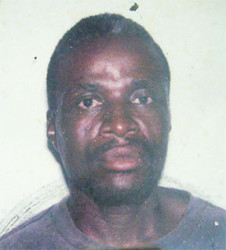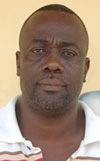The West Canje land dispute murder accused was last evening freed following a unanimous not-guilty verdict by the mixed jury.
Businessman Charles Henry called Charles Bristol and `Wheels’, who was on trial for the April, 2014 murder of Errol Lindo called ‘Son Son’, stood with his hands clasped, eyes closed and head lifted up, as the foreman revealed that the jury had found in his favour.
Addressing Henry, Justice Franklyn Holder said, “You have been found not guilty. You are free to go.”
Henry quickly exited the courtroom into the arms of friends, who quickly whisked him away in a waiting car.
Relatives of Lindo wept, and his mother, 80-year-old Viola Lindo expressed disappointment with the verdict. Her daughters were also very vocal in their displeasure as they walked out of the courtyard.

Earlier a curious crowd, which included several ranks attached to the Central Police Station, converged early in the courtroom to hear the addresses to the jury by Defence Counsel Kim Kyte and State Prosecutor Natasha Backer.
Addressing the jury, Kyte lambasted the evidence of the key prosecution witness Travis Crandon, referring to him as confused as he had expressed confusion over questions he was asked.
The witness, upon whose testimony the prosecution’s case was built, had claimed to be at the scene, yet could not recall a simple thing as the colour of the shirt Lindo had worn, nor could he recall accurately the injuries sustained, she said.
Kyte emphasized that all the other witnesses knew Lindo was dressed in an orange jersey and that he had sustained an injury to his thigh. “But the prosecution witness speaks of a blue striped shirt, along with injuries only to the torso of the now deceased,” she argued. “Travis was not there. People tell him things, but because of the bad blood which existed he had an interest to serve. He was minding cows on the accused’s land.
“You must not take his evidence with a pinch a salt, but with a pot spoon of salt.”
Kyte, a former magistrate, noted that none of the other witnesses saw Crandon at the scene of the crime. “Maybe Travis has the capability of being invisible. He is a ghost,” she reiterated.
Kyte portrayed her client as a victim of robbery, saying he was robbed of Plantation Caracas.
“We have a problem in society. We see it clearly with Travis Crandon. Some people believe that what you have, they can take it…,” she stated.
“The house was abandoned, filled with mara-buntas [stinging wasps]. The land was in the accused’s family since the 1930s. That’s the problem with society.
“The witness, Indrani Nandlall called Meena, said Lindo had not lived in the house for three months. Marabuntas were a sign of an unoccupied house,” she emphasized.

The lawyer argued that the only time a gun was introduced, was after Lindo advanced to the accused with an axe.
“The gun was never pulled during the time the woman referred to as Lindo’s sister was brandishing a cutlass. But it was after the accused’s life was threatened. You have a right to protect yourself,” she expounded. “The law gives you that right. The post-mortem revealed there was only one serious injury. The one to the neck. The now deceased was over the accused with an axe. He fired a shot to protect himself. If he wanted to kill him or cause grievous bodily harm, he could have emptied the entire barrel… The accused has established self defence.”
Backer, rebutting, said the prosecution’s case was not a web of confusion as the defence perceived, as it was a fact that the accused shot Lindo and that as a result of the injuries, he died.
“This is a case of coldblooded murder, not self defence,” she stated.
As regards the defence’s case, she noted that contractor Martin O’Brien had given a statement to the police hours after the incident. However, he forgot to give specific details surrounding the location of the accused after he had fired the shot.
Backer also brought to the jury’s attention, the evidence of the other witness Rohit Sugrim, who never gave a statement to the police, but had testified to match the unsworn testimony of the accused, and that of O’Brien.
Pointing to the evidence of the accused, Backer noted that he claimed to have been alerted by someone who said ‘look out,’ as Lindo approached with an axe. At that time, Lindo was 15 to 20 feet away and Henry’s car was on the dam. “Did he not have a choice, other than firing shots?” she questioned.
“At no time did Errol Lindo have an axe, nor did he attack the accused. Henry never attempted to assist the police by retrieving the axe.
“Mr Henry has no regard for people… He thinks he is above the law. He turned up with a gun in his waist. The witness Meena saw him load the bullets in the gun. The multiple times that Henry shot Lindo was not because he was fearful of his life, but because he wanted to ensure Lindo was dead. He refused to take Lindo to the hospital. He replied ‘ain’t he dead yet?’ in response to witness Cassandra Arthur”, she said.




